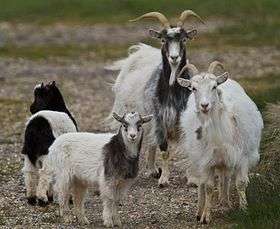Icelandic goat
|
Icelandic goats in Mýrasýsla county | |
| Country of origin | Iceland |
|---|---|
| Use | meat, milk |
| Traits | |
| Wool color | white |
| Face color | white |
| Horn status | horned in both sexes |
|
Goat Capra aegagrus hircus | |
The Icelandic goat, also known as the 'settlement goat', is an ancient breed of domestic goat believed to be of Norwegian origin and dating back to the settlement of Iceland over 1100 years ago. This breed of goat was on the verge of extinction during the late 19th century, but recovered prior to World War II, only to precipitously decline again. As of 2003, there were 348 goats in 48 flocks distributed throughout most parts of Iceland.[1] At the end of 2012, the herd had increased to 849.[2] Since this breed has been isolated for centuries, the Icelandic populations are highly inbred. The Icelandic goat is very rare outside its native land. Under its coarse, long guard hair, the Icelandic goat has a coat of high quality cashmere fiber. Icelandic goats are kept mainly as pets and their economic potential for meat, milk, cashmere and skin production remains to be explored. The Icelandic goat is currently of little economic value.[1]
The Icelandic goat is the only farm animal sponsored by the Icelandic government for the purpose of ensuring its survival. In 2014, the annual grant was ISK 4,200 (36 US dollars) per goat,[3] for a maximum of 20 goats, down from ISK 6,500 (56 US dollars) per goat in 2010, contingent upon the owner submitting a report on each animal.[4]
See also
- Norwegian Elkhound
- Norwegian Lundehund
- Norwegian Forest Cat
- Norwegian sheep landrace
- Norwegian chicken landrace
- Icelandic cattle
- Icelandic Chicken
- Icelandic Horse
- Icelandic sheep
- Icelandic Sheepdog
References
- 1 2 "The Icelandic Goat Breed, Icelandic Sheep Breeders of North America". Isbona.com. 1994-07-08. Retrieved 2014-01-08.
- ↑ Atvinnu- og nýsköpunarráðuneytið (2014). ""Niðurstöður starfshóps um málefni íslenska geitfjárstofnsins" (Conclusions of the Working Group on the Icelandic Goat Breed)" (PDF). www.atvinnuvegaraduneyti.is. p. 2. Retrieved 2015-11-24.
- ↑ Atvinnu- og nýsköpunarráðuneytið (2014). ""Niðurstöður starfshóps um málefni íslenska geitfjárstofnsins" (Conclusions of the Working Group on the Icelandic Goat Breed)" (PDF). www.atvinnuvegaraduneyti.is. p. 2. Retrieved 2015-11-24.
- ↑ Daily Life - Last Chance to See…; The Icelandic Goat (ESA), Iceland Review Online, 15 October 2010
External links
- The Icelandic Goat Breed, Icelandic Sheep Breeders of North America,
- Icelandic goats, Erfðanefnd landbúnaðarins,
- The Iceland goat: past and present, The Farmers Association of Iceland,
